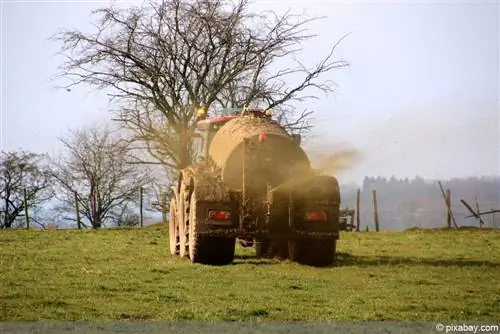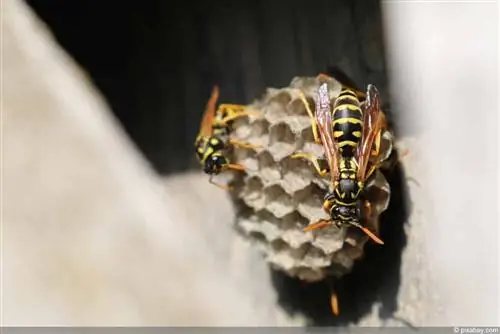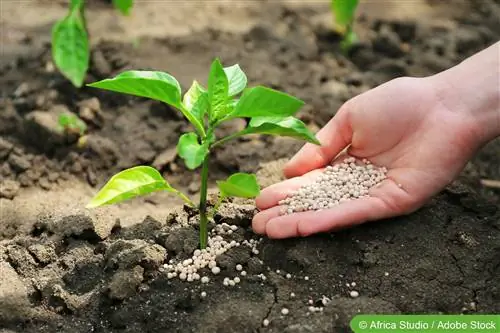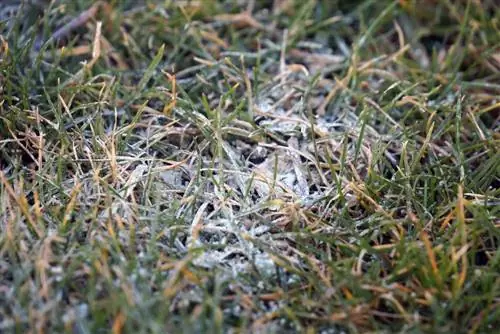- Author admin [email protected].
- Public 2023-12-17 03:39.
- Last modified 2025-01-24 12:45.
Agriculture is considered the main cause of over-fertilization: increased factory farming not only results in an overproduction of animal food, but also an enormous increase in various pollutants and manure. Over-fertilization leads to an enormous surplus of nutrients, with the nitrogen contained in the fertilizer in particular having drastic effects on the entire ecosystem.
Nitrogen
Nitrogen (N) is considered the fundamental building block of every living being and is found in water, air and soil. The vital substance makes up around 78 percent of the air, but neither plants nor animals can use the atmospheric nitrogen. However, the natural cycle requires atmospheric nitrogen to be converted by microorganisms in the soil. This creates usable molecules from the nitrogen that the plants need to grow.
As a result, animals and people absorb nitrogen through the consumption of plant foods and excrete it again through feces and urine. These are broken down again by the microorganisms, which closes the natural cycle. However, the balance of the nitrogen cycle is massively disrupted by human intervention in nature, resulting in an excess of nitrogen in the environment.
- around 62 percent comes from crop production
- around 33 percent comes from animal production
- around 5 percent come from transport, industry and households
Impact on biodiversity
The increased nitrogen supply has an enormous impact on biological diversity and ensures that the vegetation is standardized. The reason for this lies in the individual nutrient requirements of the respective plants. Some of them literally love nitrogen and benefit enormously from the excess supply of this substance. Accordingly, they spread quickly, but at the expense of those plants that have adapted to nutrient-poor conditions. Because these are subsequently displaced by the nitrogen-loving plants.
- High moors are particularly affected
- Sundew is also displaced
- Ethnic cotton grass and rosemary heather are spreading
Effects on plants

The excess nitrogen leads to unhe althy, accelerated growth of the plants and root growth falls by the wayside. The plants put all their energy into forming new shoots, which are often soft and spongy. But it's not just the shoots that are affected, because the cells and tissue are also not formed optimally. In trees, the accelerated growth also causes so-called crown thinning. This makes them much more susceptible to wind throw and drought, which often leads to wind damage in the forests. It has also been proven that factory farming and over-fertilization are directly linked to forest dieback. The oversupply of nitrogen also has the following effects on the plant world:
- The nutritional status of the plants is disturbed, which can lead to an undersupply
- Spread of bacteria and fungal diseases is increased
- Plants are more vulnerable to weather conditions
- Storage of harvested products is impaired, which can lead to a loss of yield in agriculture
Impact on water bodies
Overfertilization in agriculture leads to increased nutrient content in water bodies. The nitrogen compounds enter lakes, rivers and seas with runoff and lead to eutrophication. This refers to uncontrolled aquatic plant growth, which is caused by an excess supply of nutrients. Phytoplankton (single-celled algae) in particular benefit from this excess of nutrients and form in masses. This results in so-called algae blooms, which are greenish in color and cover the water surface. These represent a particular danger for sensitive ecosystems such as stagnant waters and slow flowing waters. Because the algae can cause the waters to “overturn”:
- Algae cover the surface
- less light reaches the lower layers of the water
- Photosynthesis cannot occur and plant growth is impaired, thereby reducing biodiversity
Phytoplankton harms water bodies
The algae have a lifespan of around one to five days. After the phytoplankton dies, it sinks to the bottom of the water and is broken down by bacteria living there. However, this process requires oxygen, which in turn is removed from the water. The lack of oxygen resulting from the aerobic degradation process leads to the death of plants and animals in the affected body of water. If there is no longer enough oxygen, toxic substances will subsequently be formed. The so-called anaerobic degradation process mainly produces toxins such as methane (CH4), ammonia (NH3) and hydrogen sulfide (H2S), which poison and kill the fish. In addition, these toxins are often found in seafood, which means they reach humans through the food chain. The algae also have the following effects:
- phytoplankton creates “dead zones”
- around 15 percent of the seabed in the B altic Sea is covered by dead zones
- phytoplankton creates “foam carpets” on the beaches
- As a result, the tourism industry suffers
Impact on climate and air

The fertilizers contain ammonium, which is converted into ammonia (NH3) during storage and application. The ammonia in turn enters the atmosphere and supports the formation of fine dust. However, this is harmful to humans and animals because it has a direct effect on the upper respiratory tract and leads to respiratory diseases. In addition, the ammonia gas can cause acid rain, which is harmful to the entire environment. When it rains, the ammonia gets back into the soil, acts as additional fertilizer and thus promotes over-fertilization of the soil.
However, the nitrogen-containing fertilizers do not only release ammonia:
- The mineralization of the fertilizer creates nitrous oxide (N2O)
- this is about 300 times more harmful to the climate than carbon dioxide (CO2)
- and is considered a highly effective greenhouse gas
- Methane (CH4) is also released
- this is around 25 times more harmful to the climate than carbon dioxide
Impact on soil
The ammonia contained in the fertilizer is converted into nitrate (NO3-) by the microorganisms in the soil. If the plants do not absorb the nitrate, a so-called base leaching occurs. The nitrate is washed out with the seepage water and soil acidification is promoted. Although some plants prefer to grow in acidic soil, all plants generally stop growing at a pH value of below 3. However, soil acidification does not only affect plant growth:
- there is a change in the soil structure
- The living conditions for soil microorganisms also change, which affects soil fertility
- The nutrients in the soil are washed out, which means that the optimal nutrient supply is no longer provided
- toxic substances can be released (e.g. aluminum)
- Decline in earthworm population
Impact on groundwater
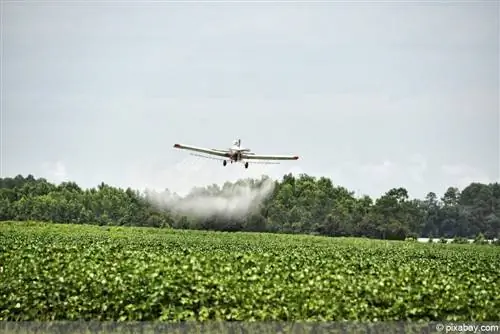
Overfertilization in agriculture is also considered a trigger for increased nitrate levels in drinking water. This is because the mobile nitrate gets into the groundwater with the seepage water and subsequently into the drinking water, especially during heavy rainfall. Although slightly elevated nitrate levels pose only a small he alth risk, persistently elevated nitrate levels can lead to inflammation of the gastrointestinal tract. In addition, the nitrate can be converted into nitrite (NO2-) in the body, which is dangerous to he alth even in small quantities. This reaction requires an acidic environment, which is why the human stomach is considered the ideal environment for this. Consuming drinking water with an increased nitrate content promotes the formation of nitrite.
- Nitrite is particularly dangerous for infants; they can “suffocate internally”
- If the nitrite gets into the blood, it disrupts the transport of oxygen because it destroys the red blood pigment
- The limit value for nitrite in drinking water is 0.50 mg/l
- The limit value for nitrate in drinking water is 50 mg/l
Note:
Plant foods can also contain high amounts of nitrates. However, these are usually not eaten every day for a lifetime.
Measures to avoid over-fertilization
The EU has already responded to nitrogen over-fertilization and established the Nitrates Directive in 1991. Accordingly, all EU member states are obliged to monitor surface water and groundwater, identify areas at risk and check them every four years. The directive also contains rules of good agricultural practice, which, however, are to be applied on a voluntary basis.
In addition to the existing laws, over-fertilization with nitrogen can also be avoided by other factors:
- Connect animal husbandry to agricultural land so that the number of animals is adjusted to the available area
- work existing manure directly into the soil
- Use high-tech methods when dispensing fertilizer, fertilizer machines with sensors and/or computer chips - this allows nitrogen to be used in a targeted manner
- Install air filter system in factory farming facilities, this can limit emissions
Frequently asked questions
Did you know that giving up meat has a positive impact on the environment?
Because the fewer animals for slaughter are bred and kept, the less nitrogen-containing emissions and manure enter the ecosystem.
Did you know that earthworms are extremely important for plants?
Because they promote aeration and drainage as well as mixing and rotting of the soil.

